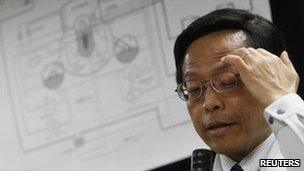Japan nuclear: Fukushima seawater radioactivity rises
- Published

Nuclear safety agency official Hidehiko Nishiyama briefed journalists
Seawater near Japan's quake-hit Fukushima Daiichi nuclear plant has a much higher level of radiation than previously reported, officials say.
In one section, radioactive iodine stood at 3,355 times the legal limit, said Japan's nuclear safety agency.
However, an official said the iodine would have deteriorated considerably by the time it reached people.
Meanwhile, the president of the Fukushima nuclear plant operator Tepco has been admitted to hospital.
Masataka Shimizu is being treated for high blood pressure and dizziness, a Tepco spokesperson said.
Mr Shimizu has barely been seen in public since the earthquake and tsunami on 11 March which damaged the Fukushima plant.
Engineers are battling to restore power and restart the cooling systems at the plant.
Tepco has been accused of a lack of transparency and failing to provide information more promptly. It was also heavily criticised for issuing erroneous radiation readings at the weekend.
Tepco officials have announced a news conference for 1500 local time (0600 GMT).
'Unpredictable'
Earlier samples had put the iodine level in the sea at 1,850 times the legal limit.
The new readings were near reactor No 1 - 300m from the shore.
Much lower - but still elevated levels - of the same radioactive element have been found in seawater as far as 16km to the south.
The BBC's Mark Worthington in Tokyo says the discovery is the strongest indication so far that highly radioactive water is leaking into the sea.
Tepco and the safety agency say the exact source of the leak is unknown.
"Iodine 131 has a half-life of eight days, and even considering its concentration in marine life, it will have deteriorated considerably by the time it reaches people," Hidehiko Nishiyama, deputy director-general of Japan's nuclear safety agency told a news conference.
Radioactive materials are measured by scientists in half-lives, or the time it takes to halve the radiation through natural decay.
Iodine 131 was blamed for the high incidence of thyroid cancer among children exposed to fallout from the Chernobyl nuclear disaster in 1986.
Japanese Prime Minister Naoto Kan discussed the crisis at Fukushima with US President Barack Obama.
Mr Obama also pledged to help the people affected by the earthquake which damaged the Fukushima plant earlier this month, the Jiji news agency reported.
Workers at the Fukushima plant are trying to prevent radioactive water from seeping into the sea.
Highly radioactive liquid has been found inside and outside several reactor buildings.
Small amounts of plutonium have also been detected in soil at the plant - the latest indication that one of the reactors suffered a partial meltdown.
But, like the discovery of plutonium, the high levels of radiation found inside and outside reactor buildings are likely to have come from melted fuel rods.
Theories for the leak centre on two possibilities - steam is flowing from the core into the reactor housing and escaping through cracks, or the contaminated material is leaking from the damaged walls of the water-filled pressure control pool beneath the No 2 reactor.
The plutonium - used in the fuel mix in the No 3 reactor - is not at levels that threaten human health, officials said.